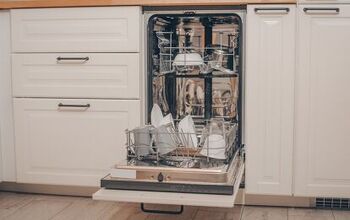What Is The Standard Dishwasher Size? (Typical Measurements)

Along with the stove and microwave, dishwashers have become integral for just about any kitchen you can find. They make cleanup easier than ever, no matter how big the occasion. Moreover, they have become quite efficient while providing maximum convenience.
The standard dishwasher measures 24” wide, 24” deep, and 33”-35” high. You can find larger dishwashers that are 30” wide and deep, and some dishwashers measure shorter than 33”. There are also compact dishwashers that are 18” or less, and they are ideal for small kitchens.
Do You Need Appliance Installation or Replacement?
Get free, zero-commitment quotes from pro contractors near you.

What is the Standard Size for Modern Dishwashers?
For just about all appliances, there are standard industry sizes. This makes it easier for the consumer to find the right appliance without having to worry about uber specific measurements. Unlike stoves and refrigerators, dishwashers really only have one main size.
Standard size. The majority of modern dishwashers will come with standard measurements of 24 inches in depth, 24 inches in width, and 35 inches in height. That last measurement is actually about 24.50-24.75” but is rounded up. Not only that, they will come with adjustable height legs for openings that are slightly bigger. Just make sure that you measure your openings before buying the dishwasher to be certain that the dimensions are of the proper size.
Custom Sizes are Available, Too
Of course, not every home setup is the same. The standard is the standard because it is the most common and popular size on the market. That said, you can always go with something larger for a more robust set of needs.
For larger dishwashers, there are versions coming in measurements of 30” all the way up to 42”. The height doesn’t change for the most part because most countertops are of a standard height. The wider dishwasher is meant to accommodate greater use.
Tiny living. On the flip side, there are spaces that just aren’t big enough to handle the standard size. For boats, apartments, and mobile homes, there are either countertop or compact dishwashers available. Compact can come in widths of 18-22”
Portable dishwashers. There is another option for smaller spaces. When you can’t really sacrifice size on your dishwasher, you can opt for a portable dishwasher. They are a bit smaller at around 18” in width but they can be stored in a closet and brought out when needed.
Other options. Every living situation is different. There are under-sink, in-sink, and even single-drawer dishwasher designs. These will all have varying dimensions that can fit the specific needs of that living space.
| Type of Dishwasher | Dimensions |
| Standard | 24” w x 24” d x 36” h |
| Large custom | 30-42” w x 24” d x 36” h |
| Compact/Countertop | 18-22” w x 24” d x 36” h |
| In-sink/Under-sink/Single-drawer | Varies based on living space |
Do You Need Appliance Installation or Replacement?
Get free, zero-commitment quotes from pro contractors near you.

Are There Standard Dimensions for Dishwasher Openings?
The standard dimensions for dishwashers come from the fact that there are standard opening sizes for dishwashers in homes. Much like the dishwasher, the dimensions are 24” in width, 24” in depth, and 34-36” in height.
There are also a few things to keep in mind when the dimensions of the dishwasher that you have been eyeing don’t quite add up:
- The Dishwasher is barely smaller. For the most part, the differences in dimension will be under 0.5”. Some of the dimensions on the dishwasher tend to be rounded up in the product specifications, but there is a small gap left so that it can slide into the opening. When the dishwasher is bigger than the opening, it won’t fit into the opening properly if at all.
- Depths include the door. When you see that 24” depth listed for either the opening or the dishwasher itself, that includes the door. Keep in mind that means the door is closed, so the depth of the internal cabinet is slightly smaller.
- Adjustable feet. The vast majority of dishwashers come with adjustable feet. For older homes, there is the chance that a dishwasher opening was added later on and might be higher by a few inches. The feet can then be opened up to mitigate the gap that would otherwise be there.
How Do I Measure the Dishwasher Opening?
If you are considering getting a new dishwasher, the first thing that you should do is get your measuring tape. Measure the rough opening. In most cases, you are simply verifying that it is the standard but, in some cases, you may find that the opening is slightly bigger or smaller than you realized. The idea is to take out the surprise element before picking out your dishwasher.
Height (H). To measure the height of the opening, start at the floor and measure to the lowest point on the countertop. Be aware of any dips in the flooring as that could play a role in the height of your dishwasher opening and impact the fit of the dishwasher.
Width (W). To measure the width, simply measure from one side of the cabinet to the other. The difference between the width of the cabinet and the width of the dishwasher should be minimal. You want a little bit of breathing room but not too much; a tighter fit is optimal.
Depth (D). When measuring the width, measure from the very back of the opening to the frontmost point of the cabinets. Remember that the door of the dishwasher will extend just past the cabinets. Be sure that there is a minimum of 27” of open space in front of the opening to accommodate for opening and closing the door.
Other Things to Consider When Measuring a Dishwasher Opening
Though most dishwasher openings are fairly standard, there are still things that you want to keep under consideration. Having all of the necessary information means choosing the proper dishwasher and not having to wonder whether it will fit the way it is meant to.
- Corner locations. If your dishwasher is going to be located in a corner, you will need more clearance. Make sure that you have at least 2” of space between the wall or cabinet and the side of the dishwasher door when it is open.
- Motor. The motor should not ever touch the floor. Look for any possible obstructions that could cause the motor of the dishwasher to touch the floor of the cabinet opening. The most common occurrences are loose, uneven tiling or carpeting. You will probably need to do a quick look to see where the motor is located so that you know what to look for.
- Flooring dimensions. The kitchen flooring that was installed under the dishwasher could have had changes done, like the adding of height. When there are multiple layers of flooring in the dishwasher opening, you will have less height to work with than most standard dishwasher openings.
The Layout of the Dishwasher Matters
Depending on the dimensions of your current living situation, you may need to decide whether you want a top control dishwasher or a front control dishwasher. There are distinct differences between the two to be aware of.
Difference between front and top control. Front control dishwashers are the standard. You can see the cycle options easily from this vantage point. Top control dishwashers, meanwhile, hide the controls to provide your kitchen space with a more streamlined look.
Interior. You will also need to take the interior of the dishwasher into consideration at some point. While the exterior dimensions rarely have an impact on the capacity of the interior, there are ways to increase dish space. Having a third rack, for instance, might help you get harder to fit items in each cycle.
Capacity Size: Compact vs Standard
The layout of your home is important when determining dishwasher size. The smaller the space, the less room there is for a dishwasher. That is why it is important to know whether or not you can accommodate a standard dishwasher.
The capacity is also important. Having an 18” dishwasher is generally a good idea for couples or small families. It can generally hold around 6-8 place settings in a single run. The regular 24” dishwasher, meanwhile, has a capacity for around 12-14 place settings and is recommended for full-size families.
Energy Consumption is Important
Another major consideration is the energy consumption of the dishwasher that you choose. Energy efficiency is extremely important these days, so limiting the amount of water and energy that your dishwasher uses is imperative.
Dishwashers that have the Energy Star symbol will not only save you on energy consumption but will likely make your utility bills smaller as well. Cycles are longer on most new models, but they use far less power and water in the process.
There are even some dishwashers that have a low water or quick wash feature to control water usage even more.
Hard Food Disposal
For some, the thought of having to scrape, rinse, and pre-wash dishes feels asinine. After all, isn’t that what a dishwasher is for? Well, by not doing that, you run the risk of food scraps getting stuck in the various components of your dishwasher.
Hard food disposal. So, having a hard food disposal unit installed right there can help get rid of grime and food residue during the rinse cycle. It costs a little more, but it may be worth it to save you the time and energy of having to scrape and prepare dishes for the dishwasher.
Self-cleaning filters. There are some higher-end units that also come with self-cleaning filters. The greater the convenience that you enjoy, the higher the cost. So, while you may not like to rinse the filter or clear off the dishes before use, it may save you quite a bit of money at the time of purchase.

Ryan Womeldorf has more than a decade of experience writing. He loves to blog about construction, plumbing, and other home topics. Ryan also loves hockey and a lifelong Buffalo sports fan.
More by Ryan Womeldorf



























